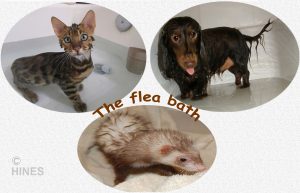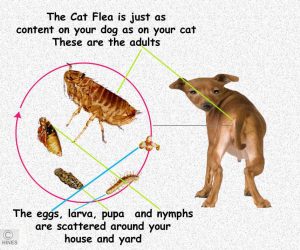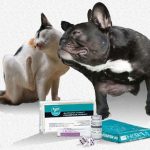Ron Hines DVM PhD
 Fleas & ticks your newer options
Fleas & ticks your newer options
 NexGard® Bravecto® Simparica® Credelio®
NexGard® Bravecto® Simparica® Credelio®
 We got too plump on the “flea shots”?
We got too plump on the “flea shots”?
Before you read this article – or any of my articles – I want you to understand that there will always be a few dogs and a few cats that do not tolerate medications that most dogs and cats have no problem with. Sometimes it was an error on the part of the person who applied it, or the wrong amount, or a miscommunication with your vet, or given too frequently. But sometimes it is just due to the individual genetic makeup or general health of your dog and cat. That goes for all effective medications that we and our pets consume. Just as some people are more attractive to mosquitoes, some dogs and cats are more attractive to fleas. I also treat ferrets. I cannot speak to the safety of these newer products in ferrets. The cost of the studies to gain FDA approval is high, so ferret studies are rarely done. For that, you will have to rely on the ferret blogs. But generally, if it’s OK for a small kitten, it is safe for ferrets as well.
Fleas are the most bothersome external parasites of pets all over the world. In northern climates they are especially troublesome from July through October. In the southern half of the Country or in pets that live in a heated environment they are a problem all year long. Fleas generate a sizable portion of veterinary hospital office visits. It is quite common for pet owners not to realize that fleas are the root of their pet’s problem and their concern. Skin infections, ear infections, personality changes, anemia, weight loss and hair loss are just some of the problems fleas can cause. Fleas transfer a number of diseases. A common mycoplasma disease spread by fleas is hemobartonellosis. It is quite common in cats. The new name for this organism is Mycoplasma haemofelis. Another flea-spread disease that affects both cats and dogs is caused by Bartonella henselae bacteria. Fleas also spread dangerous rickettsia between dogs and cats and people. (read here)
The flea bites themselves are not that painful or itchy. It is the saliva the fleas secrete that causes the irritation and itching. This itching varies from pet to pet depending on how sensitive they are to the many compounds flea saliva contain, the number of fleas they have and the pet’s individual temperament. Flea bites leave a small, reddish pimple at the site of the bite. For reasons that we do not understand, fleas tend to congregate on the pet’s rump and the dorsal base of its tail. Some people think this is because in those locations, the pets have the most difficulty catching them. But I believe there are other attractants to those areas. Another common place to find fleas on your pet is around its neck.
One or two fleas can be hard to spot. Fleas jump on and off pets all the time. So none may be present when you do your exam. Rather than look for the fleas themselves, look for the tell-tail pepper-like granules fleas leave on your pet’s skin. This material is the pet’s blood that has passed through the digestive system of the flea. If you are uncertain if this material is “flea dirt” or just dirt, pick it up on a moistened toothpick and place the granule on a white paper towel along with a drop of water. If the the rust color spreads over the paper, then your pet has a flea problem.
If one pet in your family has fleas, then they all do. No pets are immune to fleas. But when they jump onto a human being, they usually jump off relatively quickly.
Adult fleas are about 1/16 to 1/8-inch long. They are dark reddish-brown, wingless and hard-bodied. They are amazingly difficult to crush between fingers. Fleas are flattened from side to side. They have three pairs of legs. The most rear set of legs are large, enabling fleas to jump amazingly far. It is said that fleas can jump 12 inches. That would be equivalent to a human being jumping over 400 feet!
The flea’s narrow shape allows it to move rapidly through your pet’s fur. Fleas have mouth parts that pierce the skin and then siphon out blood. Fleas lay their eggs on the pet’s body. The eggs are smooth, oval and white. The flea larvae that hatch from these eggs are about 4 millimeters long. They are grub-like, slender, and off-white in color.
Flea larva fall off of the pet and live in cracks and niches along your floor and in stuffed furniture where they feed on dead organic matter. Out-of- doors, they prefer sandy, shaded soils. Flea larva do not suck blood. They do actively avoid light. After a time, these larva develop into pupae with a silken capsules covered with particles of the debris in which the larval fleas lived.
The time it takes a flea to complete this life cycle is extremely variable. It can be as short as two weeks or as long as eight months. The length of a flea’s life cycle is dependent on air temperature as well as a natural staggering of hatching time.
Fleas lay about five hundred eggs in their lifetime. At any one time, about 5% of the fleas associated with a pet are adults on the pet. The rest are about evenly divided between eggs, larva and pupa. So, you are dealing with a lot more fleas than meet the eye.
Fleas wait motionless on the ground or in bedding. When an object cuts off the light shining on the flea – it hops. It is not a brainy creature. If it lands on a pet it is satisfied. If it lands on a person it usually leaves soon after. Certain people are more susceptible to flea bites than others. We do not know why.
A rather unique characteristic of fleas is that a large portion of them will remain dormant in their cocoons until vibrations, body warmth, and carbon dioxide emanating from pets or people cause them to hatch. This is why new occupants of apartments that appear free of fleas can suddenly be attacked by hoards of fleas a day or two later. Adult fleas in this resting stage can live for up to one year. Once they have left their cocoons they can only survive about a week without feeding on a pet.
The most common fleas encountered in the United States on cats and dogs are cat fleas, Ctenocephalides felis. Dogs also harbor their own dog flea, Ctenocephalides canis.
Fleas are the carrier of the most common tapeworm of dogs and cats, Dipylidium caninum. These tapeworms do not infect humans. They are not the same tapeworms pets get from eating raw meat or rodents. Some pets are so efficient in catching fleas that no fleas are ever found in their coat. But veterinarians know that they have a flea problem when they find the rice-like tapeworm segments on their stool or anus. You can read about tapeworms in your pet here.
How Can I Solve My Pet’s Flea Problem?
The easiest place to kill fleas are after they have been attracted to your pet. I do not suggest that you have your house fumigated. None of the chemicals that are used for fumigation or general application in the home are good for you or your pet. But that does not keep exterminators from marketing their services.
Because flea problems are so common and persistent, there are an enormous number of products on the market. I update my articles from time to time. However, it is hard to keep up with the changing choices that you have. The latest products are the isoxazolines, NexGard®, Bravecto® and Simparica®. You can read about all of them here. I wrote that article in 2016. In 2018, Elanco introduced their version, Credelio®. Fleas have an amazing ability to eventually become resistant to the products we develop to kill them. If you are dissatisfied with the effectiveness of an older, less expensive flea-control product that once worked for you, either your pet’s exposure to fleas has increased or it is time to try a newer product. If you use an effective, safe, flea-control product on all your pets, fleas will disappear from your home on their own in a month or two.
Humid, southern climates are more challenging. So are carpeted homes. Folks who take their pets to areas where dogs and cats congregate are also considerably more likely to reintroduce fleas into the household. Doggy parks, feeding your pets from dishes kept out in the yard, the maintenance of nearby feral cat colonies, allowing your cat or dog to roam, all make a persistent flea problem much more likely. These habits also increase the potential of exposure to non-flea related disease that are a threat to you and your pet – diseases like leptospirosis and Lyme disease. The lifestyles of your neighbors can make controlling these elements a challenge. I know of cases where my clients had to supply free flea control products to their neighbors to get a flea and tick problems under control.
If you have a flea problem in a young puppy, kitten, ferret or debilitated animal, you are always safest if you dampen a cotton ball with 70%alcohol and hold it over the flea until it no longer moves. Then pluck each up with tweezers, drop them into a paper cup of potent alcoholic beverage and flush them down the commode.
There are too many flea control products on the market for me to cover them all. So, I will mention some that have done a good job on pets here in South Texas where I live and in Southern Florida – two of the most challenging locations for combating fleas. The mild climate and high humidity of these areas make them two of the worst flea-infested areas in America. If they work well for us here, they will work well for you.
Product instructions change as new information becomes available. So, I would prefer you rely on the most current product label found on the product container you buy or on the manufacturer’s website than the ones I have posted here.
Never Use A Product With Only A Dog On The Label or Box On Your Cat
Fipronil Containing Products Like Frontline, Effitix® And PetArmor®:
These products are still quite effective in killing adult fleas. Some contain added methoprene, an insect growth regulator that decreases the flea’s ability to reproduce. Others have added pyriproxyfen or lufinuron for the same effect. If used as directed, they are all safe. Because the patent on fipronil has expired, veterinarians and the large pharmaceutical companies that produced them for veterinarians to sell no longer market these products like they once did. But they remain quite effective.
These are all oil-soluble ingredients. So, they rely on the natural oils in your pet’s hair coat and skin to maintain their effectiveness. Regardless of what the packages say, a soap and water bath soon after they are applied will decrease their effectiveness or decrease the length of time these products are effective. I suggest you wait two days after bathing your pet before you apply any of these products and a week after application before you bathe the pet again.
Imidocloprid Containing Products Like Advantage II®, Advantage Multi®, Advocate Spot On®:
Bayer still has the patent on imidocloprid-containing dog and cat products, so as far as I know, it is not available over-the-counter. Imidocloprid like fipronil is an oil soluble liquid applied to the pet’s coat. When you apply any of these oil-soluble products, try to have the snout of the applicator vial in direct contact with the dog or cat’s skin. A dab here, a dab there – especially around the neck and near the rump. If you have a dog, using Advantage Multi provides added protection against heartworms. That product contains moxidectin which seems to control resistant heartworms better than ivermectin-containing products such as Heartgard®. You can read more about heartworm resistance here.
Selamectin Containing Products Like Revolution®:
Revolution® (selamectin, Zoetis Co.) is also quite effective in controlling fleas. In addition, selamectin controls heartworms. It is also a topical product. I have seen a few dogs in which the product seems to irritate their skin. That can be minimized by putting no more than one drop on each area of the skin to which it is applied.
Comfortis® (Spinosad):
Comfortis® (spinosad, Lilly/Elanco Co.) Spinosad is a commonly used agricultural pesticide with low toxicity to mammals. It is derived from naturally occurring soil bacteria. It is used by many organic gardeners. The compound is considered quite safe. Comfortis® is an oral formulation of spinosad. I actually mist my dog off with the agricultural product because I have reservations about giving products internally when they are just as effective when used topically. Of course, I cannot suggest that to you because flea control with these agricultural products is is not a government-approved use. It is only a pleasant side effect. There have been a few reports of side effects when giving spinosad in pill form in addition to pets that are taking ivermectin to prevent heartworms.
Vectra®:
Vectra® Dog and Vectra Cat (dinotefuran + pyriproxyfen + permethrin, Ceva Co.). The active ingredient, dinotefuran is an agricultural pesticide with a history of low toxicity. Since fleas have had little exposure to dinotefuran until recently, it should prove effective for a while.
This product is popularly dispensed by veterinarians because company policy prevents it from being purchased on the internet or elsewhere at a discounted price. I understand that packages of this product are imprinted with “Blood Hound” track-and-trace bar code technology that allows the manufacturer to quickly locates veterinarians selling it in bulk to third parties who then sell products at discounted prices. (track & trace) Just like you, veterinarians need to earn an income; but as a general rule for my pets, I avoid products that use heavy-handed marketing techniques like that to restrict access and maximize profits – particularly when there are so many other good products to choose from.
Pyrethrin/ Piperonyl butoxide:
Pyrethrin is an extract of the flowers of certain chrysanthemum plants grown in East Africa. It is the active ingredients in many supermarket flea powders, shampoos and sprays. Piperonyl butoxide is used to enhance its strength. These products do kill fleas, and they are very safe. But they do not solve a flea problem in your home or yard because they have no residual activity. Within a mater of hours, new fleas will jump on your pet from its environment. They are excellent to de-flea a pet before you adopt it and move it to your home. Pyrethrin only kills adult fleas. So, I prefer using shampoos to de-flea pets rather than mists or sprays because the soap in shampoos will wash away the larva and eggs that are on the pet as well. So, although flea baths are old hat, they still have their usefulness.
The Isoxazolines: NexGard®, Bravecto®, Simparica®, Credelio®
You can read more about these products here. These four isoxazoline-containing flea control products are the newest entrants in the flea and tick-control wars. They are oral, chewable products that most pets accept readily. They are also effective new treatments for both demodectic and sarcoptic mange. That is because all those organisms (as well as ear mites) depend on a “bug” (arthropod) nervous system that is quite different from the one you and your furry pets share. Some claim to work a bit longer than others. But I believe they are all very similar in how long they last, how effective they are and their safety profiles. The pharmaceutical companies producing them see these products as restoring their dominance in a market where older patents have expired. They also jealously guard against “diversion” of their products to mass marketing stores and internet discounters. If you are averse to putting drops on your pet or using one of the newer flea collars I mention next, or if your pet does not do well or resists the application of topical medications then these four products might have advantages for you. There is a caution on the label of most of these products that they be used with special care (if at all) in pets with a history of seizures or neurological abnormalities.
New Generation Flea Collars:
Old fashion flea collars were very limited in their effectiveness. They sometimes worked for a week or two. By the time most of my clients come in for office calls, at best, there are no fleas under the flea collar.
Seresto®:
In 2013, Bayer took two of their older compounds, imidacloprid (the same ingredient in their Advantage® line) and combined it with flumethrin, a souped up version of the old pyrethrins, that has been used safely topically on livestock for many years. They then launched Seresto®, a flea and tick collar designed with “Sustained-Release Technology”. But the key to the product’s claimed effectiveness were not the drugs themselves, it was Bayer’s polymer department that found a method to impregnate a special plastic polymer collar with the two compounds in a way that they claim releases the chemicals slowly over an 8-month period. Just like the other products on the market that contain these chemicals, they can, occasionally produce side effects. When they do, it is often the nervous system that is affected. Today the product is marketed by Elanco.
You are on the Vetspace animal health website
Visiting the products that you see displayed on this website help pay the cost of keeping these articles on the Internet.




